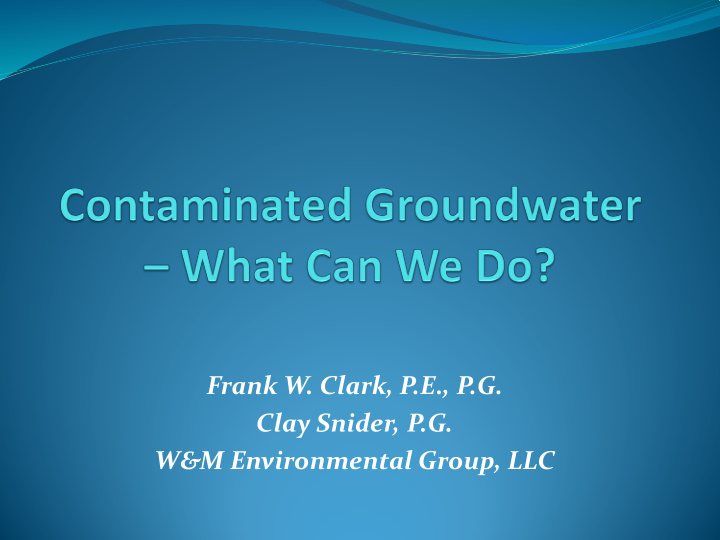



Frank W. Clark, P.E., P.G. Clay Snider, P.G. W&M Environmental Group, LLC
Meet the Experts Clay Snider, P.G. Frank Clark, P.E., P.G. Remediation Division Manager Technical Director
Oh, No….We Found Groundwater Contamination Site investigations for real estate transactions or industrial closures often identify groundwater contamination. The most frequent COCs in urban areas are volatile organic compounds, petroleum hydrocarbons, and heavy metals Groundwater cleanup is almost always the most challenging aspect of site remediation
Cliff Notes on Historic Approaches to Groundwater Cleanup Pre-1970’s – non-existent 1970’s-1980’s – US EPA, RCRA and Superfund 1980’s-1990’s – advent of Environmental Site Assessments; States develop cleanup rules
Leaking Underground Storage Tanks Over 540,000 Leaking USTs in USA
Groundwater Cleanup Approaches Pump & Treat Systems
In-Situ Approaches
Cliff Notes on Historic Approaches to Groundwater Cleanup 1990’s – Underground storage tank market explodes; risk-based corrective action concepts are developed 2000’s – Failure of traditional remediation approaches recognized; RBCA techniques refined We haven’t done a good job cleaning up contaminated groundwater!!!
The Groundwater Cleanup Conundrum Presumed that all groundwater should be fit for potable purposes Groundwater issues drive most remediation Poor job of “engineering” groundwater remediation The costs and time associated with groundwater cleanup are too burdensome on most properties Other methods have their limitations
Risk-Based Cleanup Options in Texas Demonstration of low yield aquifer (no “beneficial use”) Monitored natural attenuation – let Mother Nature take care of it Plume Management Zones (PMZs) – show plume stability and no harmful effects beyond the plume boundary
Municipal Setting Designations - The Concept • Historic industrial activities were prevalent in many large urban areas • Most urban areas have municipal water supplies • Potable water often derived from deep aquifers or surface water reservoirs So……restrict groundwater so it cannot be used for • Urban groundwater impacts often do not potable purposes threaten potable water
Urban / Municipal Setting Designations Concept first developed in Ohio in 1990’s Introduced in Texas Legislature-2003 Stated purpose was to “provide a less expensive and faster alternative to rules governing the cleanup of contaminated groundwater” Results in a deed-recorded restriction on the use of groundwater from beneath the Site for potable purposes.
The MSD Process - Screening Public water available to properties within ½- mile? Wells within ½ mile radius? Support likely from local government ? Support likely from cities within ½ mile? Support likely from RPUs within 5 miles? Exceed MSD-adjusted cleanup standards on the property?
MSD Application Process – Local Governments Formal application process and fees Very specific technical submittals (chemicals types, source areas, plume stability, regulatory status, etc.) Deeds, registered surveys, affidavits Public meeting scheduled City Council hearing for approval
MSD Process – Water Well Notices Notice required to all well owners within 5 miles Three attempts at notice must be documented Most urban wells are abandoned or unknown to current owner Can involve 100-200 notices in DFW MetroPlex Can involve 800-1,200 notices in Houston
MSD Process – TCEQ Approval All the hard work is done…… After approval of local government, separate application submitted to TCEQ TCEQ reviews carefully to ensure administrative aspects of the rule are met TCEQ issues an MSD Certificate that certifies the MSD
Benefits of an MSD - Relaxed Water Cleanup Standards Groundwater Increase Chemical of Occurrence Ingestion PCL Air Inhalation in Concern (mg/L) PCL (mg/L) Cleanup w/o MSD w/MSD Target Benzene Component in 0.005 180 36,000x gasoline Trichloroethylene Degreasing 0.005 162 32,400x (TCE) chemical Tetrachloroethene Dry cleaning 0.005 327 65,400x (PCE) solvent Lead Leaded gas, 0.015 DNA --- urban pollution Arsenic Pesticides 0.010 DNA ---
Benefits of MSDs – Reduced Delineation Assessment levels for TCEQ investigations become the MSD-adjusted levels Little delineation and “plume chasing” required
Benefits of an MSD - Relaxed Soil Cleanup Groundwater Chemical of Occurrence Protective Human Health Increase Concern PCL PCL in (mg/kg) (mg/kg) Cleanup w/o MSD w/MSD Target Benzene Component in 0.026 66 2,538x gasoline Trichloroethylene Degreasing 0.034 152 4,470x (TCE) chemical Tetrachloroethene Dry cleaning 0.050 98 1,960x (PCE) solvent Lead Leaded gas, 500 167x 3* urban pollution Arsenic Pesticides 24 4.8x 5*
MSDs in North Central Texas Most cities rely principally on surface water reservoirs Potable wells generally >1,000 feet deep Contamination typically perched (10-30 feet deep) in unconsolidated deposits Austin Chalk, Eagle Ford Shale and Taylor Marl prevent vertical migration to underlying aquifers.
Geology in DFW MetroPlex
Case Study- Urban Brownfield Site Urban shopping center since 1960’s Dry cleaner occupied one suite for 20+ years Contamination found in Brownfields Site Assessment PCE, TCE and DCE present Chlorinated solvent plume migrated off-Site
Urban Shopping Center PCE Plume
MSD Benefits to Client Non-profit agency (CDC) could not afford expensive monitoring or cleanup MSD process was supported by the City Cleanup criteria adjusted, resulting in no response actions Chemical of Max Detected Groundwater Groundwater Concern in Water PCL w/o MSD PCL with (mg/L) (mg/L) MSD (mg/L) PCE 0.767 0.005 327 TCE 0.077 0.005 162 Cis-1,2-DCE 0.327 0.070 16,000
Summary of MSD Benefits Reduced cleanup values for contaminated groundwater Eliminates most plume delineation Reduced groundwater monitoring Reduced soil cleanup values A predictable closure strategy (time and $)
MSD Challenges Involves local government and public participation Third parties (e.g. RPUs) need to provide written support MSDs do not include off-Site properties If potable wells within ½ mile, response actions? Does not address vapor intrusion issues
Contact Us Frank Clark, PE, PG Clay Snider, PG Technical Director Division Manager W&M Environmental Group W&M Environmental Group fclark@wh-m.com csnider@wh-m.com 972/509-9611 972/349-1731
Recommend
More recommend